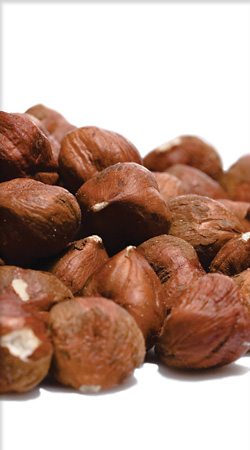
American’s interest in overall wellness, specifically through exercise and diet, has allowed for a renewed focus on superfoods, and more specifically, items like the hazelnut.
The oval-like hazelnut grows in clusters of up to five and is considered the edible fruit of the hazel tree, of the Genus Corylus, which is commonly found in many European woodlands. The hazelnut shell falls from the fuzzy outer husk of the tree 7–8 months after pollination, leaving a pale scar at the base of its dark brown shell. This process normally occurs at the end of the autumn season.
 Currently, the leading producer of the exotic-tasting hazelnut is Turkey, accounting for 75 percent of worldwide production. However, in America, hazelnut production is most concentrated in Washington and Oregon. Interestingly enough, the hazelnut is the state nut of Oregon.
Currently, the leading producer of the exotic-tasting hazelnut is Turkey, accounting for 75 percent of worldwide production. However, in America, hazelnut production is most concentrated in Washington and Oregon. Interestingly enough, the hazelnut is the state nut of Oregon.
Hazelnuts can be collected by using a harvesting machine or by gently shaking the branch to encourage the nuts to fall. Once gathered, the nuts are normally dried within the shell (best within 24 hours), but a considerable amount of time and heat can be saved by shelling the nut before drying.
Widely known for its delightful crunch and distinct flavor profile, the hazelnut has a plethora of other lesser-known secrets under its hard shell. The sophisticated taste of the hazelnut may have been successful in boosting its popularity, but it is also one of the most nutritious types of nuts.
According to hazelnutcouncil.org, the hazelnut is an excellent source of vitamin E, dietary fiber, magnesium, heart-healthy B vitamins, and is a natural source of antioxidants and nutrients that have cardio-protective benefits like arginine, the amino acid that relaxes blood vessels. Hazelnuts are beginning to gain recognition for their nutritional value by leading health authorities like the American Heart Association and National Institutes of Health. With heart disease being the number one killer of men and women in the United States, the hazelnut is a “heart smart” snacking alternative. According to the FDAApproved Health Claim for Nuts, scientific evidence suggests that eating 1.5 ounces of nuts such as the hazelnut may help reduce the risk of heart disease when combined with a diet low in saturated fat and cholesterol. Aside from its many health benefits, including Paclitaxel which is utilized in cancer chemotherapy treatment and found in the shells and leaves of the hazel tree, the hazelnut can be employed in a variety of creative culinary ways
Hazelnuts are a great garnish and texture enhancement to any baked treat, and they add an addictively nutty flavor to pasta and salads. Additionally, hazelnuts serve as a gluten-free alternative to flour-based coating for meat, fish and poultry. Roasted hazelnuts produce hazelnut butter, which can be used as a flavoring element for soups, beverages and even salad dressing. Hazelnut oil can be used to enrich the taste of sauces, sauté, stir-fry and marinades. Last, hazelnuts can be ground with or without sugar to create flavorful pastes, which can be used to make an array of premium desserts including pastries and gelato.
According to the Hazelnut Council’s 2008 research, 90 percent of consumers who have tried hazelnuts like them. Furthermore, 54 percent of Americans would like to try a new ice cream or frozen dessert with hazelnut. Because consumers view the hazelnut as healthy, indulgent and exotic, 76 percent are likely to purchase a hazelnut product simply because of their positive perception of the food.
With the American palate swaying more toward ethnic, exotic flavors that also provide nutritious benefits, there’s no question that the hazelnut would be a key ingredient for chefs of all kinds.
Sources:
hazelnutcouncil.org
answers.com
oregonstate.edu
USDA Nutrient Database
